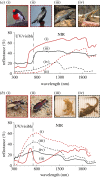Thermal consequences of colour and near-infrared reflectance
- PMID: 28533462
- PMCID: PMC5444066
- DOI: 10.1098/rstb.2016.0345
Thermal consequences of colour and near-infrared reflectance
Abstract
The importance of colour for temperature regulation in animals remains controversial. Colour can affect an animal's temperature because all else being equal, dark surfaces absorb more solar energy than do light surfaces, and that energy is converted into heat. However, in reality, the relationship between colour and thermoregulation is complex and varied because it depends on environmental conditions and the physical properties, behaviour and physiology of the animal. Furthermore, the thermal effects of colour depend as much on absorptance of near-infrared ((NIR), 700-2500 nm) as visible (300-700 nm) wavelengths of direct sunlight; yet the NIR is very rarely considered or measured. The few available data on NIR reflectance in animals indicate that the visible reflectance is often a poor predictor of NIR reflectance. Adaptive variation in animal coloration (visible reflectance) reflects a compromise between multiple competing functions such as camouflage, signalling and thermoregulation. By contrast, adaptive variation in NIR reflectance should primarily reflect thermoregulatory requirements because animal visual systems are generally insensitive to NIR wavelengths. Here, we assess evidence and identify key research questions regarding the thermoregulatory function of animal coloration, and specifically consider evidence for adaptive variation in NIR reflectance.This article is part of the themed issue 'Animal coloration: production, perception, function and application'.
Keywords: animal coloration; energy budget; infrared; melanism; thermal melanism; thermoregulation.
© 2017 The Author(s).
Conflict of interest statement
We declare we have no competing interests.
Figures



Similar articles
-
The current and future state of animal coloration research.Philos Trans R Soc Lond B Biol Sci. 2017 Jul 5;372(1724):20160352. doi: 10.1098/rstb.2016.0352. Philos Trans R Soc Lond B Biol Sci. 2017. PMID: 28533467 Free PMC article. Review.
-
Climate predicts both visible and near-infrared reflectance in butterflies.Ecol Lett. 2021 Sep;24(9):1869-1879. doi: 10.1111/ele.13821. Epub 2021 Jun 26. Ecol Lett. 2021. PMID: 34174001
-
Fluorescence as a means of colour signal enhancement.Philos Trans R Soc Lond B Biol Sci. 2017 Jul 5;372(1724):20160335. doi: 10.1098/rstb.2016.0335. Philos Trans R Soc Lond B Biol Sci. 2017. PMID: 28533452 Free PMC article. Review.
-
Interactions between colour-producing mechanisms and their effects on the integumentary colour palette.Philos Trans R Soc Lond B Biol Sci. 2017 Jul 5;372(1724):20160536. doi: 10.1098/rstb.2016.0536. Philos Trans R Soc Lond B Biol Sci. 2017. PMID: 28533449 Free PMC article. Review.
-
Climate is a strong predictor of near-infrared reflectance but a poor predictor of colour in butterflies.Proc Biol Sci. 2019 Mar 13;286(1898):20190234. doi: 10.1098/rspb.2019.0234. Proc Biol Sci. 2019. PMID: 30862288 Free PMC article.
Cited by
-
Genetic colour variation visible for predators and conspecifics is concealed from humans in a polymorphic moth.J Evol Biol. 2022 Mar;35(3):467-478. doi: 10.1111/jeb.13994. Epub 2022 Mar 3. J Evol Biol. 2022. PMID: 35239231 Free PMC article.
-
The current and future state of animal coloration research.Philos Trans R Soc Lond B Biol Sci. 2017 Jul 5;372(1724):20160352. doi: 10.1098/rstb.2016.0352. Philos Trans R Soc Lond B Biol Sci. 2017. PMID: 28533467 Free PMC article. Review.
-
Behavior and thermal comfort of light and dark coat dairy cows in the Eastern Amazon.Front Vet Sci. 2022 Sep 14;9:1006093. doi: 10.3389/fvets.2022.1006093. eCollection 2022. Front Vet Sci. 2022. PMID: 36187817 Free PMC article.
-
Evidence of Seasonal Variation in Body Color in Adults of the Parasitoid Cirrospilus pictus (Hymenoptera: Eulophidae) in Sicily, Italy.Insects. 2023 Jan 13;14(1):90. doi: 10.3390/insects14010090. Insects. 2023. PMID: 36662018 Free PMC article.
-
Genetic and environmental drivers of colour and pattern in the Australian jacky dragon (Amphibolurus muricatus).J Evol Biol. 2022 Sep;35(9):1229-1239. doi: 10.1111/jeb.14066. Epub 2022 Jul 21. J Evol Biol. 2022. PMID: 35861703 Free PMC article.
References
-
- Walsberg GE. 1983. Coat color and solar heat gain in animals. Bioscience 33, 88–91. (10.2307/1309169) - DOI
-
- Burtt EH, Ichida JM. 2004. Gloger's rule, feather-degrading bacteria, and color variation among song sparrows. The Condor 106, 681–686. (10.1650/7383) - DOI
-
- Campbell GS, Norman JM. 1998. An introduction to environmental biophysics, 2 edn New York, NY: Springer Science & Business Media.
Publication types
MeSH terms
LinkOut - more resources
Full Text Sources
Other Literature Sources
Miscellaneous

